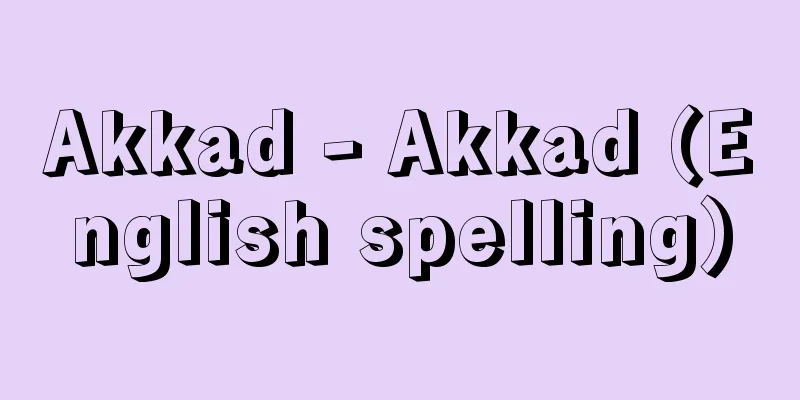Bomber - Bakugekiki (English spelling) bomber

|
A military aircraft loaded with bombs for bombing enemies. developmentThe first aerial bombing attack was reported in 1911, when Italian planes dropped four 2-kilogram grenades on Turkish troops. However, when World War I began, full-scale bomber development began, and in addition to light bombers for attacks on the battlefield, large bombers for long-distance operations were also created. At that time, light bombers could only carry 100 to 200 kilograms of bombs, and even large bombers could only carry 0.5 to 1 ton, so their power was not that great. However, it is noteworthy that Germany used Zeppelin airships and large bombers to bomb Britain, aiming to destroy morale. A total of 113 air raids were recorded to have caused 1,415 deaths, and the effect of the bombing was very small, but this was the beginning of strategic bombing. After that, efforts were made to develop bombers as the main aircraft of the air force, alongside fighter planes, and they grew into a fighting force that could decide the course of the war during World War II. [Katsuhiro Fujita] World War IIBombers at that time were called different names and had different uses depending on the country, but generally they could be divided into four-engine heavy bombers for strategic bombing, twin-engine medium bombers for tactical bombing, and single-engine light bombers for supporting ground troops. Attack aircraft and fighter bombers, which were lighter than light bombers, were also used for ground attacks. These bombing forces had a great impact on ground combat, but strategic bombing also reached a scale that was incomparable to that of World War I. During World War II, British and American bombers and fighter planes dropped about 2.7 million tons of bombs on the European front, and nearly half of that was used for strategic bombing of Germany itself. This included indiscriminate bombing of cities, and the deaths from bombing reached about 300,000. Meanwhile, the B-29 air raids on Japan, with approximately 160,000 tons of bombs and two atomic bombs, resulted in more than 300,000 deaths (including more than 100,000 from the atomic bombs alone) and the depletion of Japan's war potential, forcing it to surrender. [Katsuhiro Fujita] After World War IIAfter World War II, long-range bombers, which gained enormous destructive power through the use of nuclear bombs, came to play an extremely important role as the core of strategic nuclear attack forces. Later, when intercontinental ballistic missiles with nuclear warheads and then submarine-launched ballistic missiles were put into practical use, the significance of strategic bombers relatively diminished, but both the United States and the Soviet Union continued to maintain them as part of their strategic nuclear attack forces. The reasons the United States claimed to maintain strategic bomber units were that bombers have greater destructive power than missiles, are flexible in terms of target selection, aborting attacks after a sortie, and being deployed in conventional battles, and that they can force the Soviet Union to spend a lot on air defense. The B-52, which has been the mainstay of American strategic bombers since the mid-1950s, can attack anywhere in the world by receiving mid-air refueling, and can carry up to 20 missiles with an explosive yield of 20 kilotons, or six to eight missiles and four nuclear bombs (which come in several types, from 15-20 megatons to adjustable-yield types), so it certainly has a great offensive power. Furthermore, as demonstrated during its deployment in the Vietnam War, it is also effective for conventional bombing, taking advantage of its bomb carrying capacity of up to 22 tons. On the other hand, bombers were at risk of being destroyed on the ground in a surprise attack by ballistic missiles, and the biggest problem was whether they could penetrate the enemy's air defense network. Therefore, the United States equipped the B-52 with long-range cruise missiles to give it long-distance attack capability, deployed the B-1 variable-wing bomber, which could fly at high speed at extremely low altitudes and was difficult to detect by radar, and also developed the B-2 stealth bomber, which was difficult to detect by radar. After the end of the Cold War, the weight of strategic nuclear attack power in the military balance decreased, and the number of bombers possessed by the United States and Russia decreased considerably, but the reason why bombers are still used is because they have great power for attacks with conventional weapons. The United States has converted its swing-wing B-1 bomber to conventional bombing only (removing the nuclear weapon delivery device), which is meaningful in conformity with the agreement between the United States and Russia to reduce the total number of strategic weapons, but it can also be said to be an indication of its intention to utilize bombers, which have a much larger weapon load and flight range than small fighter or attack aircraft, for conventional combat. The B-52 and B-2 are also used in conventional combat, but Russia (formerly the Soviet Union), which has the capability to operate nuclear weapons and once possessed a large number of long-range bombers to rival the United States, uses the Tupolev Tu-95, a B-52 class bomber, and the Tu-160, which is slightly larger than the B-1, as bombers for both nuclear and conventional attacks, although the number of aircraft is much smaller. As such, it appears that large, long-range bombers will continue to be used in the future, but the smaller class of bombers known as tactical bombers have faded into the background as the capabilities of fighter-bombers and attack aircraft have improved dramatically since the jet age, and have disappeared in Western countries. However, Russia believes that bombers with medium range have some value (it also assigns them to the naval aviation unit, where their main mission is to attack ships), and so it continues to use the Tu-22M. [Katsuhiro Fujita] [Reference] | |German twin-engine bomber. Wingspan 23.7m, overall length 12.2m, total weight 3.975t, maximum speed 140km/h, range 835km, first flight 1917 ©Shogakukan Library "> Gotha GⅤ The US Army's main four-engine bomber. Wingspan 31.62m, total length 22.66m, total weight 29.7t, maximum speed 462km/h (the above figures are for the later B-17G model), first flight 1935 (illustration shows B-17G model) ©Shogakukan Library "> Boeing B-17 Flying Fort... British twin-engine bomber. Wingspan 16.51m, overall length 13.56m, total weight 10.4t, maximum speed 657km/h, first flight 1940 (numbers are for B16 type) ©Shogakukan Library "> de Havilland Mosquito American bomber. Wingspan 35.36m, total length 32.57m, total weight 83.9t, maximum speed 1014km/h (numbers for B-47E), first flight 1947 (illustration shows B-47E) ©Shogakukan Library "> Boeing B-47 Stratojet American swing-wing strategic bomber. Wingspan 41.67-23.84m, overall length 44.83m, total weight 216.4t, maximum speed Mach 1.2, first flight 1974 ©Shogakukan Library "> Rockwell B-1 Source: Shogakukan Encyclopedia Nipponica About Encyclopedia Nipponica Information | Legend |
|
爆弾を積んで敵を爆撃するための軍用機。 開発空からの爆撃は、1911年イタリア軍の飛行機がトルコ軍に対し重さ2キログラムの手榴(しゅりゅう)弾4個を投下したのが最初とされているが、第一次世界大戦が始まると本格的な爆撃機の開発が行われ、戦場で攻撃にあたる軽爆撃機とともに、長距離作戦用の大型爆撃機も生み出された。当時の軽爆撃機は爆弾の搭載量が100~200キログラムにすぎず、大型爆撃機でも0.5~1トン程度で、威力はたいしたことがなかった。だが、ドイツがツェッペリン飛行船と大型爆撃機によりイギリスを空襲し、士気の崩壊をねらったことは注目に値する。計113回の空襲による死者は1415人と記録されており、その爆撃効果はごく小さかったが、これが戦略爆撃の始まりであった。その後、爆撃機は戦闘機と並ぶ空軍の主力機種として開発に力が入れられ、第二次世界大戦時には戦争の流れを決する戦力にまで成長した。 [藤田勝啓] 第二次世界大戦時そのころの爆撃機は国によって呼び方や用途が多少異なるが、一般的にみれば戦略爆撃用の四発重爆撃機、戦術爆撃を行う双発の中型爆撃機、地上部隊支援用の単発軽爆撃機に分けることができ、軽爆撃機より軽快な攻撃機や戦闘爆撃機も対地攻撃に用いられた。こうした爆撃兵力が地上戦闘に与えた影響は大きいが、戦略爆撃のほうも第一次世界大戦とは比較にならないほどの規模に達した。第二次世界大戦中にイギリスとアメリカの爆撃機と戦闘機がヨーロッパ戦線で投下した爆弾量は約270万トンにも達するが、その半分近くがドイツ本国に対する戦略爆撃にあてられたのである。それには都市に対する無差別爆撃も含まれたので、爆撃による死者は約30万人に達した。 一方、日本に対するB-29の空襲は、約16万トンの爆弾と2発の原爆により、30万人以上の死者(うち原爆だけで10万人以上)と戦争遂行力の枯渇をもたらし、日本を降伏に追い詰めた。 [藤田勝啓] 第二次世界大戦後第二次世界大戦後、核爆弾により強大な破壊力を身につけた長距離爆撃機は、戦略核攻撃力の中心としてきわめて大きな位置を占めるようになった。その後、核弾頭をつけた大陸間弾道ミサイル、ついで潜水艦発射弾道ミサイルが実用化されると、相対的に戦略爆撃機の意義は薄れたが、それでも米ソ両国は戦略核攻撃力の一部として戦略爆撃機を維持し続けた。アメリカが戦略爆撃機部隊を保持する理由として主張したのは、爆撃機はミサイルより破壊力が大きく、また目標の選択、出撃後の攻撃中止、通常戦闘への投入などの点で運用に柔軟性があり、そしてソ連に防空のための大きな出費を強いることができる点であった。1950年代なかばからアメリカ戦略爆撃機の主力となっているB-52は、空中給油を受けることによって世界のいかなる場所でも攻撃でき、爆発威力20キロトンのミサイルを最大20発、あるいはミサイル6~8発と核爆弾(15~20メガトン級のものから威力調整可能式のものまで何種かある)4発を積めるから、確かに攻撃力は大きい。またベトナム戦争に出動したことで実証されているように、通常爆撃にも最大22トンという爆弾搭載能力を生かして威力を発揮する。 その反面、爆撃機は弾道ミサイルによる奇襲攻撃を受けて地上で破壊される危険性があり、そして最大の問題として、相手の防空網を突破しうるかという点が問われた。そこでアメリカでは、B-52に長射程の巡航ミサイルを搭載して遠距離攻撃能力をもたせる一方、レーダーに発見されにくい超低空を高速で飛べる可変翼爆撃機B-1を配備し、さらにレーダーに探知されにくいステルス爆撃機B-2も開発した。 冷戦が終結したあと、軍事バランスにおける戦略核攻撃力の比重が減少し、アメリカおよびロシアが保有する爆撃機の数はかなり少なくなったが、それでも爆撃機を使い続けているのは、通常兵器による攻撃にも大きな威力を備えるからである。アメリカが可変翼爆撃機B-1を通常爆撃専用に変更(核兵器専用の投下装置は除去)したりしているのは、戦略兵器の総数を減らしていくという米ロの合意にあわせるという意義もあるが、小型な戦闘機や攻撃機よりずっと大きな兵器搭載量と航続力を備える爆撃機を、通常戦闘に活用するという意思の表れといえよう。B-52とB-2は通常戦闘にも使われるが、核兵器の運用能力を保持しており、かつてアメリカに対抗して多数の長距離爆撃機を保持していたロシア(旧ソ連)でも、機数はずっと少なくなっているが、B-52クラスのツポレフTu-95と、B-1より一回り大型なTu-160を、核攻撃と通常攻撃を兼ねる爆撃機として使っている。 このように大型長距離爆撃機は今後も使われ続ける形勢にあるが、それより小型な戦術爆撃機とよばれたクラスの爆撃機は、ジェット時代に入って戦闘爆撃機や攻撃機の能力が大きく向上したため、影が薄くなり、西側諸国では姿を消したが、ロシアでは中程度の航続力をもつ爆撃機はそれなりの価値があると考え(海軍航空部隊にも配属し、艦船の攻撃を主任務とさせている)、Tu-22Mを使い続けている。 [藤田勝啓] [参照項目] | |ドイツの双発爆撃機。翼幅23.7m、全長12.2m、総重量3.975t、最大速度140km/h、航続距離835km、初飛行1917年©小学館ライブラリー"> ゴータGⅤ アメリカ陸軍の主力4発爆撃機。翼幅31.62m、全長22.66m、総重量29.7t、最大速度462km/h(以上の数値は後期のB-17G型)、初飛行1935年(図はB-17G型)©小学館ライブラリー"> ボーイングB-17 フライングフォート… イギリスの双発爆撃機。翼幅16.51m、全長13.56m、総重量10.4t、最大速度657km/h、初飛行1940年(数値はB16型)©小学館ライブラリー"> デ・ハビランド・モスキート アメリカの爆撃機。翼幅35.36m、全長32.57m、総重量83.9t、最大速度 1014km/h(数値はB-47E型)、初飛行1947年(図はB-47E型)©小学館ライブラリー"> ボーイングB-47 ストラトジェット アメリカの可変翼戦略爆撃機。翼幅 41.67~23.84m、全長44.83m、総重量216.4t、最大速度マッハ1.2、初飛行1974年©小学館ライブラリー"> ロックウェルB-1 出典 小学館 日本大百科全書(ニッポニカ)日本大百科全書(ニッポニカ)について 情報 | 凡例 |
<<: Bakugou (English spelling) detonation
>>: Bombing - Bakugeki (English spelling)
Recommend
Hidradenitis Suppurativa (English name)
[What kind of disease is it?] If heat rash continu...
Theatre Shincho - Engeki Shincho
A theater magazine. (1) The first edition: January...
Household electrical appliances
...By 1970, it had grown rapidly and become huge,...
Sublime Porte
… [The rise of local powers] In the 18th century,...
Augusta National Golf Course
...Because of the soft grass and wide fairways, t...
Shoren-in style
This school of calligraphy was founded in the Nan...
Coastal Fisheries - Engangyogyo
Fisheries conducted near shore. They are conducte...
Sheshonq
...After that, the political center shifted compl...
Goldschmidt, Richard Benedict
Born: April 12, 1878 in Frankfurt am Main [Died] A...
Japanese American Citizens League
... After the war, a large number of Japanese ret...
Khajuna
...there are between 20,000 and 40,000 speakers. ...
Banla City Site (English: Banla City Site)
An earthen wall from the Bohai period located abou...
Reichsmarsch
…The second most powerful man in the Nazi Party a...
Bingling Temple Grottoes - Bingling Temple Grottoes
This cave temple is located in the Xiaojishi Moun...
Takarabe [town] - Takarabe
A former town in Soo County in the eastern part of...









